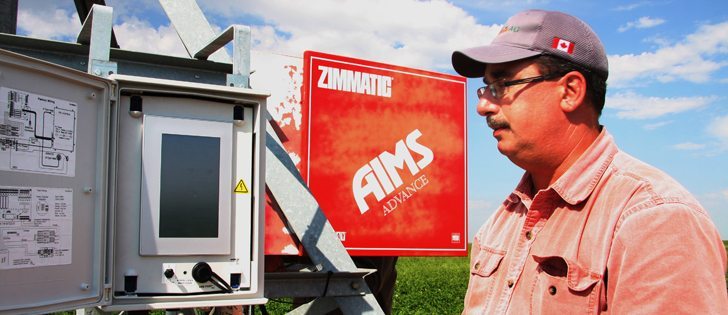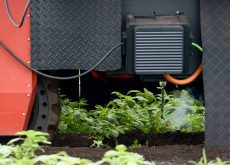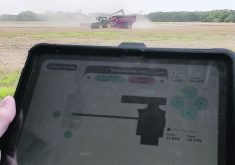Technology taken to next level | Project uses field data and prescribes fertilizer and water requirements in each zone
CHIN, Alta. — Jeff Bronsch knows polygons. Boy, does he know polygons.
The president of Sunrise Ag, a farm production management business based in Taber, Alta., looks at thousands of shapes every day as he examines data in field maps.
From two potato fields, he deciphers maps of electrical conductivity, soil moisture, topography, elevation, infiltration capacity and growth stage data. He collates that with data and images from RTK, GPS, satellite, and aircraft photography.
Then he writes a prescription for computerized application of a specific amount of water to specific areas of the field — differing among the thousands of polygons on his maps. And he changes that prescription weekly based on plant growth stage, rainfall and disease issues.
Read Also

Bunge’s crop mix is changing
Bunge has predominantly been a soybean processing firm, but that’s about to change after the merger with Viterra with softseed processing and grain merchandising gaining ground.
Sound complicated?
You ain’t seen nothin’ yet.
Add in a fertigation system, which applies varying rates of liquid fertilizer to multiple sectors of the field based on observed and tested plant development and health, and you’ve got a job with mind-boggling data and equally boggling possibilities.
There’s one more thing: the field has a control strip, a strip for half the recommended rates, and the “rock star” area where inputs are calculated throughout the season for maximum production.
Bronsch is working with potato farmers Chris and Harold Perry, who initiated the VRI and variable rate fertigation project. It’s the first time such detailed prescriptions have been attempted and applied anywhere in Canada and quite possibly the world.
The data is complicated but the goal is simple.
“It’s just utilizing the technology to its full capacity,” said Chris Perry.
VRI technology has been around for years but modern field mapping techniques can take the application several steps further.
“I think the difference today is with the remote sensing, being able to take a picture and have it tell us information, and the variable rate irrigation. We focus on irrigation because it’s the high value input/output for the crop.”
Chris, president of a Perry Farms initiative called Grow the Energy Circle Ltd., said irrigation accounts for half of the farm’s electrical use. VRI has the potential to reduce that use and associated cost, while maximizing potato production and returns.
Two potato fields with pivots, one of them 130 acres and one 115, are involved in the project. One uses Valley irrigation equipment and the other uses Zimmatic, each with VRI technology.
They have slightly different systems but each has sprinklers electronically controlled by pressure valves that will allow water to pulse as well as simply shut on and off.
Using data from field maps and images, Bronsch uses a system called FieldLook to write prescriptions that dictate how much water each sprinkler distributes, thus minimizing flow in low spots and adjusting for slope and soil type.
“It’s really a blend between soils and topography … the slope of the field and the depressions, and growth,” said Bronsch.
“As the season goes on, we put more emphasis on growth. Where it’s strong, we want to meet the needs of that growth.”
Potatoes are a high-input crop typically grown on lighter soils. Plants have a shallow rooting depth and require soil moisture no less than 65 percent.
“So we have a shallow rooted crop. We have a light texture and we have a pretty aggressive allowable depletion level, so it doesn’t leave us a lot of manageable water in the soil,” said Bronsch.
“We really have to be on top of things when we irrigate potatoes because in some cases, with the light sand, we only have maybe 20 milli-metres of water between that allowable depletion in field capacity that’s available to the crop.”
Ted Harms, soil and water specialist with Alberta Agriculture’s irrigation branch, is also part of the project, which he said is the first of its kind in Canada.
Though VRI capability has long been available, farmers haven’t embraced it.
As technology improves, allowing better control through GPS and re-lated electronics, Harms thinks more people will see the advantages.
Harms is monitoring soil water content using rain, soil water sensors near the surface and several profiling sensors in different field zones.
“It’s fairly intensive monitoring of soil water and irrigation applications,” he said.
Bronsch uses this data to confirm the accuracy of his irrigation prescriptions and to write new ones that change with conditions and crop growth stage.
The ability to change irrigation and fertilizer applications many times during the growing season is key to the project, said Perry.
“A lot of people are taking VR technology and will take histories and will take the Veris map and put on prescriptions at the start of the year. What we’re trying to do is utilize the technology to not only adjust our water input, we’re also adjusting our nutrient input, specifically nitrogen.”
Bronsch said the fertilizer aspect created challenges. While trying to deliver precise amounts of nutrients to specific areas of the field, some parts received less than optimum water.
“We had to tie an injection system in, put a flow meter in the system to make sure that that rate stays the same, so it created a few challenges in figuring out how much product we’re going to put on, how much water we’re going to need,” said Bronsch.
“It certainly was challenging to me, anyway, trying to figure this all out. I think we’ve got the kinks out of it. And we’re certainly pushing some of the hardware to meet the needs in the field.”
Ideally, the amount of water and fertilizer applied will maximize production throughout the field, creating one management zone.
“It sounds simple in concept, which is our job, and we’re utilizing Jeff to make it work,” said Perry.
Though the amount of data is vast, ideally he and Harold would like it boiled down to three zones of high, medium and low water and fertilizer demands.
Then, the two would like to be able to sit down each morning, examine the data and devise a field prescription for the week.
Harms agreed that greater simplicity will be key to any greater adoption of VRI and VR fertigation.
“Jeff has expertise that few have. There’d be no way most people could do this with the prescriptions and stuff,” said Harms.
“It’s a whole realm and level of complexity in an irrigation circle than there was before, and fertigation, that takes it to a whole new level.”
Harms said in-field monitoring will always be needed so producers will have confidence in electronic field data.
“And it’s going to have to be localized. It’s a localized prescription that you need and irrigators have to have the person making the prescriptions in fairly close proximity to their operations.”
Bronsch agrees on the need for simplicity.
“I think there’s a great opportunity for growers with VRI and there’s a great opportunity for…water savings and dropping the amount of inputs we have to put into it. But there has to be a fairly simple process for a grower to deploy that.”
Success will be measured by field production but even that is easier said than done. It will involve frequent sampling during harvest. A seven-foot test strip gives an estimate of tons per acre.
“We have a heck of a time predicting yield,” said Perry. “We go out and dig in the field and we’ll get dramatic differences on seven foot digs all the way through.”
By managing irrigation and fertilizer, the Perrys hope to even out potato production levels and maturity in the field. Potatoes of similar quality will store well and qualify for bonuses offered by processors.
“That’s where there’s a real value for a grower that has fields that are challenging,” said Bronsch. “VRI certainly has a benefit, and that would probably extend to all crops.”
The project has surprised and intrigued irrigation equipment manufacturers, said Perry. It was the first install of some of the equipment for local suppliers.
Bronsch said it’s now evident that systems are needed to feed more digital input directly into the irrigation system so growers can make changes quickly and conveniently from a home computer or handheld device.
“We’re hoping to have the discussion with (manufacturers) throughout this process to improve those tools so the grower can utilize the hardware because it’s the software and the interface with that hardware that’s important here,” he said.
“I think that will come. I’m hoping there will be value to the manufacturers to hear that from this project and what we’re doing here, to see that there’s opportunities to make it easier for the grower.”
The Perrys plan to continue the project next year. Harms said he’s looking forward to it.
“We can get fairly comfortable and get fairly complacent with what we do, but I told (Chris), thank you for forcing us all into the deep end, because that’s what he’s done. We’ve really gone out of our comfort zone here.”
















